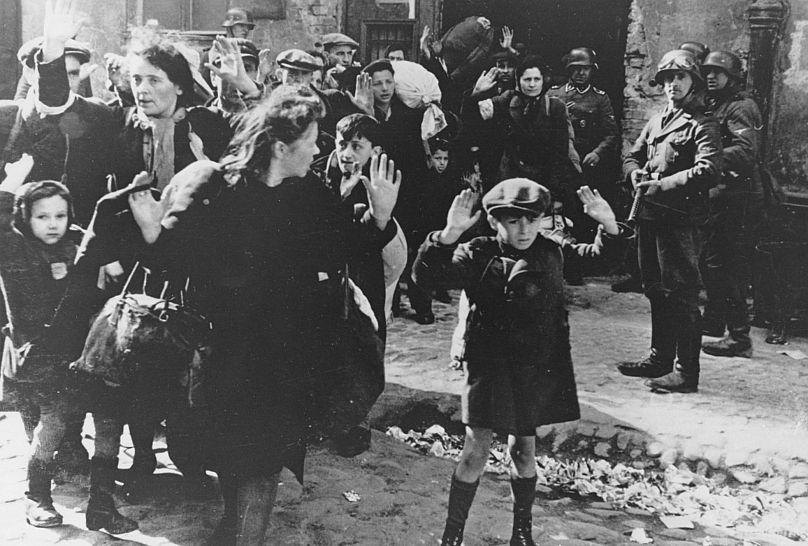At a poignant and solemn ceremony, the German, Polish and Israeli presidents came together in the Polish capital to commemorate 80 years since the Warsaw Ghetto Uprising.
Presidents and Holocaust survivors and their descendants commemorated the 80th anniversary of the Warsaw Ghetto Uprising on Wednesday with a poignant sense that the responsibility for carrying on the memory of the Holocaust is passing from the witnesses.
Germany's President Frank-Walter Steinmeier said the lessons of his own country's aggression hold a lesson as Russia's attack on Ukraine has “destroyed the foundations of our European security order”.
“You in Poland, you in Israel, you know from your history that freedom and independence must be fought for and defended. You know how important it is for a democracy to defend itself,” Steinmeier said at a ceremony alongside presidents Isaac Herzog of Israel and Andrzej Duda of Poland.
“But we Germans have also learned the lessons of our history. ‘Never again’ means that there must be no criminal war of aggression like Russia’s against Ukraine in Europe.”
The anniversary honours the hundreds of young Jews who took up arms in Warsaw in 1943 against the overwhelming might of the Nazi German army.
There are no surviving fighters still alive. Marek Edelman, the last surviving commander, died in 2009. He remained in Poland and helped keep alive the memory of the revolt in his homeland. Simcha Rotem, a fighter who smuggled others out of the burning ghetto through sewage tunnels, died
The commemorations took place in front of the Memorial to the Ghetto Heroes where the fighting erupted, led by three presidents whose nations were forever shaped by World War II.
Israel was founded after the war to give Jews a home where they could finally be safe after centuries of persecution in Europe.
Germany, which inflicted death and destruction across the vast areas that it occupied, has acknowledged its crimes and expressed remorse.
Steinmeier once again begged forgiveness
“As German Federal President, I stand before you today and bow to the courageous fighters in the Warsaw ghetto,” Steinmeier said. “I bow to the dead in deep sorrow.”
And Poland, where Europe’s largest prewar Jewish population lived and which was invaded and subjected to mass death and destruction, carries out its responsibility of preserving sites like the ghetto and the Auschwitz death camp, while also honouring the massive losses inflicted on the entire nation.
Some six million Polish citizens were killed during the war, about three million of them Jews and the others mostly Christian Poles.
“Dear President Duda, dear President Herzog, many people in your two countries, in Poland and in Israel, have granted us Germans reconciliation despite these crimes," Steinmeier said, calling that a “miracle of reconciliation” to be preserved into the future.
Some of those participating in Wednesday’s observances travelled from as far as Australia and the United States to honour those who perished, but also the rich Jewish civilisation that is their heritage. Many hold their own private ceremonies, paying tribute to those departed at the Jewish cemetery or at various memorials on the former grounds of the ghetto.
The Germans invaded Poland in 1939 and the next year set up the ghetto, the largest of many in occupied Poland.
It initially held some 380,000 Jews who were cramped into tight living spaces, and at its peak housed about a half-million souls. Disease and starvation were rampant, and bodies often appeared on the streets.
The Jewish resistance movement in the Warsaw ghetto grew after 265,000 men, women and children were rounded up in the summer of 1942 and killed at the Treblinka death camp. As word of the Nazi genocide spread, those who remained behind no longer believed German promises that they would be sent to labour camps.
A small group of rebels began to spread calls for resistance, carrying out isolated acts of sabotage and attacks. Some Jews began defying German orders to report for deportation.
The uprising began when the Nazis entered the ghetto on 19 April, 1943, the eve of the Passover holiday. Three days later, the Nazis set the ghetto ablaze, turning it into a fiery death trap, but the Jewish fighters kept up their struggle for nearly a month before they were brutally vanquished. That was longer than some countries held out.












